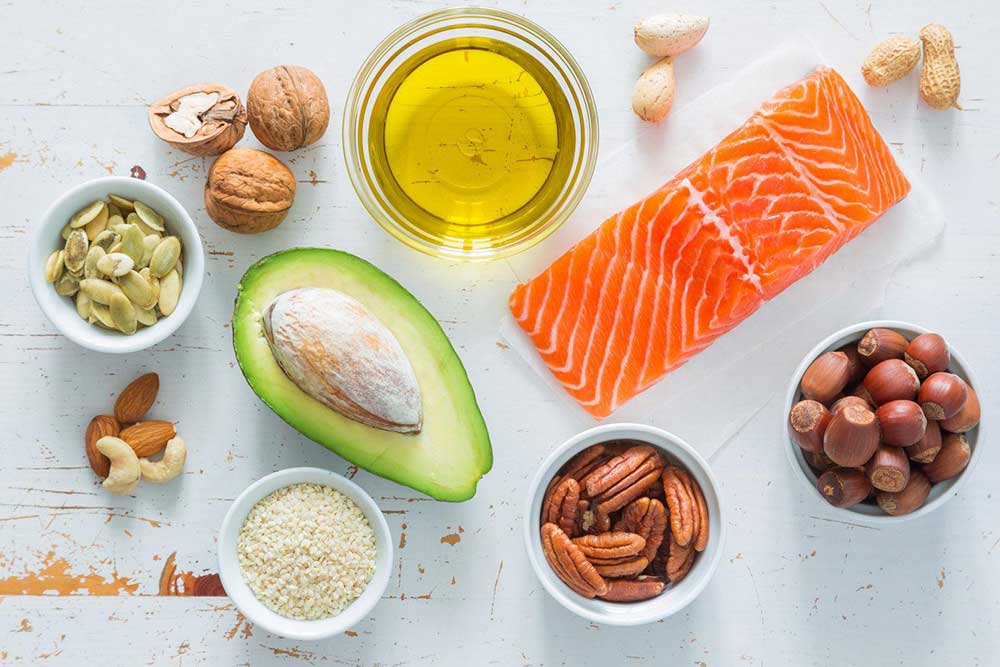What’s the deal with healthy fats? Which fats are the “bad fats”? The confusion about fat is one of the most notorious topics in nutrition. Until a few years ago, fat was vilified by just about everyone – including professional health organizations and health care professionals – as the root cause of heart disease and obesity.
More recently, the dialog around fat has shifted. Now we are embracing fat like never before as a key nutrient for heart health, hormone support, and even weight loss. Should you jump on the fat bandwagon or is this just another fad? Keep reading to learn about healthy fats, which fats you should avoid, and which fats are right for your body.
What are fats?
Fat is a key macronutrient that supports health in many ways. There are three main categories of fats (aka fatty acids): saturated, monounsaturated, and polyunsaturated fats.
Each of these fats have a different chemical structure that gives it different properties and functions in the body. Within each category of fat, there are several different types of fatty acids. For example arachidonic acid and gamma-linolenic acid (GLA) are different types of polyunsaturated fats.
One of the most important things to keep in mind about fat is that all plant and animal fats contain a combination of different types of fatty acids. For example, lard is considered saturated fat, but it actually contains more monounsaturated fat (45%) than saturated fat (44%). In fact, most of the monounsaturated fat found in lard is oleic acid, which is the same fatty acid that gives olive oil its heart health benefits! Likewise, olive oil is largely considered a monounsaturated fat despite containing 14% saturated fat. This explains why so much of the research on fat has conflicting results.
Why you need to eat fat
Fats are one of our primary energy sources; we must consume them in order to survive. Over the last few years, the importance of fat has become so evident that the 2015 US Dietary Guidelines for Americans eliminated the upper limit once placed on fat intake.
Fats insulate our organs and serve as structural components of our cells. They support immune function, help regulate our body temperature, maintain healthy skin, hair and nails, and help us absorb essential fat-soluble vitamins like vitamin A, D, E, and K. Some fats, like omega-3 fatty acids and monounsaturated fats, fight inflammation, and support heart and brain health. Other fats like cholesterol serve as a building block for hormones. Eating fat is more than just a fad.
Which fats are healthy fats?
Generally speaking, “healthy fats” are fats that support the cardiovascular system, balance hormones, and fight inflammation. The trouble is that not everyone agrees which fats are healthy fats and which fats are bad fats. Here’s a breakdown of the current research on certain fats.
Monounsaturated fats
Pretty much everyone can agree that monounsaturated fats are healthy fats, especially when it comes to the heart.
Monounsaturated fatty acids, or MUFAs, have one (“mono”) point in their carbon chain that is “unsaturated” with hydrogen. This results in a double carbon-to-carbon bond. The chemistry can be a bit intimidating, but the key thing to remember is that the chemical structure of MUFAs makes them liquid at room temperature and solid when refrigerated. Additionally, MUFAs are sensitive to heat and light. This is why extra virgin olive oil usually comes in darker bottles and smokes easily with high heat cooking.
Foods that contain mostly MUFAs are:
- Hazelnuts
- Cashews
- Olives and olive oil
- Avocado and avocado oil
- Macadamia nuts
- Almonds
- A few animal fats like poultry and pork.
MUFAs reduce LDL cholesterol (aka “bad cholesterol”) and triglycerides, and increase HDL (aka “good cholesterol”), making them ideal for heart health. They also reduce oxidation and inflammation, lower blood pressure, and improve insulin sensitivity.
Omega-3 polyunsaturated fats
Most experts agree that omega-3 fatty acids are healthy fats. Omega-3s are an essential fat that belong to a group of fats called polyunsaturated fatty acids, or PUFAs. PUFAs have multiple double bonds along their carbon chain that enable them to deactivate harmful compounds in the body, such as free radicals. PUFAs are liquid at both room and refrigerated temperatures. They are very sensitive to light and heat, and are prone to oxidation and rancidity. Refrigerate PUFAs and avoid using them in cooking.
There are actually several types of omega-3 fatty acids, but the most important ones are ALA, EPA, and DHA. These omega-3s are critical for the proper functioning of our immune, inflammatory, cardiovascular, and nervous systems. We cannot synthesize omega-3s in our body, so we must get omega-3s from our diet. Several studies show that eating omega-3 fatty acids from fish decreases the risk for heart disease and sudden cardiac death. Research has also shown that omega-3s lower triglycerides and blood pressure.
The best source of omega-3 fatty acids are cold-water, fatty fish like salmon, mackerel, herring, sardines, anchovies, and bass, as well as shellfish like oysters and mussels. Plant-based sources of omega-3 like walnuts, flax and chia seeds need to be converted to the active forms of omega-3 (DHA and EPA) in the body. As a result, solely consuming plant sources of omega-3 may not be sufficient for meeting needs.
Which fats are unhealthy fats?
Trans fats
Trans fats are universally considered “bad fats.” There are two main types of trans fats: artificial trans fats and naturally occurring trans fats.
Artificial trans fats are usually made by adding hydrogen to liquid vegetable oils to create a fat that is solid at room temperature. Commonly referred to as hydrogenated fats on food labels, these fats are found in many processed foods, such as:
- Crackers, cookies, cakes, frozen pies, and other baked goods
- Snack foods (such as microwave popcorn)
- Frozen pizza
- Fast-food
- Vegetable shortenings and some stick margarines
- Coffee creamer
- Refrigerated dough products
- Ready-to-use frostings
Artificial trans fats may increase the risk of cancer, heart disease, obesity, and other inflammatory conditions—even at relatively low doses. Naturally occurring trans fats like conjugated linoleic acid (CLA) are found in small amounts of grass-fed animal meat and dairy products. These fats have been associated with a lower risk of heart disease, improved glucose tolerance, reduced cancer risk, and may even help promote weight loss. In summary, we need more research to understand how naturally occurring trans fats influence our health, but for now it seems like we can take them out of the “bad fat” category.
Omega-6 polyunsaturated fats
Omega-6 is a polyunsaturated fat also known as linoleic acid. It is essential to human health, but too much of this fatty acid may promote inflammation. Food sources of omega-6 include industrial seed oils like canola, peanut, soybean, and sunflower oil. They are also found in smaller amounts in nuts and seeds.
When eating foods with omega-6 fatty acids, it’s important to make sure you are also getting enough DHA and EPA to minimize the pro-inflammatory effects omega-6’s might have. To do this, limit your intake of vegetable oils like canola, soy, peanut, etc. which are the most concentrated source of omega-6 fatty acids, and meet your needs through whole foods like walnuts, chia seeds and avocado.
Cholesterol
In 2015, the US Dietary Guidelines for Americans in 2015 eliminated recommendations to restrict cholesterol after 30 plus years. That’s because although some people are genetically predisposed to high cholesterol, the vast majority of people can consume dietary cholesterol with little impact on their blood cholesterol. We actually make cholesterol in our body because we have a very high demand for it. Cholesterol serves as the building block for many of our hormones, vitamin D, and is a key structural component of our cells.
Cholesterol is a “good fat” for most people. However, dietary cholesterol can increase LDL cholesterol for a small percentage of the population genetically predisposed to hyper-absorb cholesterol in the diet. We can take cholesterol out of the “bad fat” category and put it in the “it depends” category.
Saturated fats
Saturated fats (SF) are probably the most controversial of all the fats. They are solid at room temperature and suitable for high-heat cooking due to their hydrogen-saturated carbon chains. While traditionally viewed as “bad fats” for their potential to raise LDL cholesterol, recent research suggests they may not be as harmful as once thought. SFs come in varying lengths – long, medium, and short chains. Long chain SFs, prevalent in milk and meat, are the primary form of fat storage in our bodies. Notably, one long-chain SF, stearic acid, may even lower LDL cholesterol.
Medium chain SFs (MCTs) like lauric and caprylic acid in coconut milk and breast milk offer quick energy and antimicrobial properties. They may enhance fat burning and also improve digestion as they are rapidly absorbed and can provide a quick source of energy for individuals with certain digestive conditions or those who have difficulty absorbing fats. Short chain SFs (butyric, propionic, and acetic acid) found in grass-fed butter and produced by gut microbiome fuel colon cells and aid in cell signaling.
Saturated fats’ impact on individuals varies based on sensitivity to LDL cholesterol levels. Whole foods rich in saturated fats also provide beneficial monounsaturated and polyunsaturated fats, potentially mitigating risks. Certain saturated fats affect both LDL and HDL cholesterol, potentially leading to a more balanced heart disease risk. Recent research emphasizes measuring LDL particle count (LDL-P) as a key marker for cardiovascular risk.
We don’t have all the answers yet, but we’re starting to think that saturated fat isn’t necessarily “bad” for everyone – it depends on the individual.
The bottom line on fats
Fats are vital for various bodily functions, providing more calories per gram than protein or carbs. While excess consumption can lead to weight gain, they also promote a sense of fullness and help manage appetite. Opt for fatty fish over fish oil supplements for optimal omega-3 intake to support heart health. If you have been diagnosed with familial hypercholesterolemia, it’s important to monitor saturated fat and cholesterol intake. For others, these fats generally don’t adversely affect blood lipids, but consulting blood work for personalized cardiovascular risk assessment is advisable.
Need help figuring out how to integrate healthy fats into your diet? Book a session with a Culina Health dietitian for personalized nutrition advice.






